Evaluating the Clogging Behavior of Pervious Concrete (PC)Using the Machine Learning Techniques
Jiandong Huang,Jia Zhang and Yuan Gao
1School of Mines,China University of Mining and Technology,Xuzhou,221116,China
2School of Chemical Engineering and Technology,China University of Mining and Technology,Xuzhou,221116,China
ABSTRACT Pervious concrete (PC)is at risk of clogging due to the continuous blockage of sand into it during its service time.This study aims to evaluate and predict such clogging behavior of PC using hybrid machine learning techniques.Based on the 84 groups of the dataset developed in the earlier study,the clogging behavior of the PC was determined by the algorithm combing the SVM(support vector machines)and particle swarm optimization(PSO)methods.The PSO algorithm was employed to adjust the hyperparameters of the SVM and verify the performance using 10-fold cross-validation.The predicting results of the developed model were assessed by the coefficient of determination(R)and root mean square error(RMSE).The importance of the influential variables on the clogging behavior of PC was evaluated as well.The results showed that the PSO algorithm can effectively adjust the hyperparameters of the SVM model and can be used to construct the predictive model for the clogging behavior of the PC.The combined algorithm has the advantage of higher reliability and validity than the random hyperparameters selection.For the verification process,the developed model was able to obtain values of 0.9469 and 1.8148 for the R and RMSE,showing that the developed machine learning model can accurately be used to evaluate and predict the clogging behavior of the PC,guiding the mix-design of PC from the perspective of durability.The size of the clogging sand is the most important parameter and the thickness of the sample is the least significant factor affecting the clogging behavior.The proportions of the smallest aggregate size and largest aggregate size are the two most important design parameters of concrete with the consideration of the relatively higher importance scores,showing these two aggregates should be given special attention in future PC design for anti-clogging purposes.
KEYWORDS Clogging behavior; pervious concrete; SVM; PSO
1 Introduction
With the gradual development of the economy and society,China is vigorously promoting the process of environmental protection and striving to build “sponge cities” to build a harmonious relationship between humans and nature [1-7].The so-called “sponge city”is to modify the urban infrastructure,increase the versatility of the basic building facilities,and form a “spongy body”that does not accumulate water on the road on rainy days and relieves the surface temperature on sunny days [1,5,6].At present,most pavements in China are composed of asphalt concrete,hindering the water-air circulation of the city and accelerating the emergence of the heat island effect [8-10].To improve the atmospheric circulation and urban environment,pervious concrete(PC)was proposed as a new type of green construction material [11,12].As a kind of new construction material,it is gradually showing its development advantages:(1)on the one hand,by laying pervious concrete,the surface runoff after heavy rain can penetrate the ground and reduce the pressure on municipal drainage facilities; (2)on the other hand,pervious concrete can penetrate the surface water into the soil to supplement the moisture in the soil and regulate the urban ecological environment [13-17].However,as the PC is playing its role of infiltration,it is inevitable that some small particles such as dust,sand,and gravel can penetrate the PC with the water.The reduced permeability of PC can shorten the service life of the pavement.For instance,it was found that the permeability of the PC was reduced by 90% after it was put into use for 5 years,resulting in impervious pavement that is unable to withstand urban flooding and freeze-thaw damage [13,18,19].
As one kind of paving material that can be used in practical engineering construction,PC has basically met the practical engineering requirements after many years of experimental research.However,the main factors affecting the wide practical application of the PC are mainly reflected in its durability [10,20].PC is composed of coarse aggregate,cement,water,and water-reducing agent.The coarse aggregate is taken as the skeleton,and the cement slurry is wrapped outside the coarse aggregate to bond the coarse aggregate particles to form the point contact or surface contact of space [21-24].Due to the particularity structure of PC,it contains a lot of pores inside.This is both an advantage and a disadvantage of the PC compared to the conventional concrete [19].Due to the existence of pore structure,the skeleton of PC is not a continuous whole structure,so that the external media,especially water,air,small dust,and so on,can enter freely,which is very unfavorable to the durability [3,18,25-27].Borgwardt [28] evaluated the effects of aggregate compositions on the clogging behavior in PC and pointed out that the decrease of permeability depends on the aggregate sizes used for the design of the mixtures.Kayhanian et al.[10,25] analyzed the PC with varying service time by the field tester of penetration coefficient and drew the conclusion that the permeability coefficient of the PC drooped to one-thousandth of the new one and the most significant influencing factor is the clogging sand with the sizes of smaller than 38 microns.It can be seen that the earlier studies have considered the effects of the composition of the mixture and the diameter of the clogging sand on the clogging performance of PC.However,as far as the authors know,the prediction of the clogging behavior of PC has not been effectively studied.
With the development of artificial intelligence technology,various machine learning models are gradually used to evaluate and predict the performances of concrete materials [29-40].Varying machine learning techniques have been used to evaluate the mechanical strength of the reinforced concrete (RC)slab [3,41].Jamal et al.[42] analyzed the potential to use the multiple linear regression and adaptive neuro-fuzzy reasoning systems for the estimation of the strength of recycled aggregate concrete (RAC).Khademi et al.[43] used the same method in a follow-up study to predict the compressive strength of RAC after curing of 28 days.The machine learning model was adopted by Armaghani et al.[44] to model the shear capacity of the concrete beam.The artificial neural network-based modeling approach was used for the strength prediction for concrete incorporating agricultural and construction wastes [45].The machine learning model was also used to evaluate the mechanical properties of concretes containing waste foundry sand [46].The measured results of the methods mentioned above were consistent with the predicted ones,indicating that the machine learning techniques are feasible for the performance prediction of the concrete materials.However,limited studies can support accurate and efficient artificial intelligence techniques that specifically target the clogging behavior of PC.Also,it should be noted that the above machine learning techniques have been successfully adapted to the prediction of the concrete materials,but these studies still have the limitations of uncertainty,time-consuming and low efficiency.Therefore,it is necessary to propose more efficient and simple machine learning techniques to evaluate the clogging behavior of the PC.
2 Research Objective
The main research objective of the present study is to predict the permeability of the PC after the clogging materials penetrate through.The PSO algorithm was employed to obtain the optimized structure of the SVM model,combining to construct a hybrid machine learning technique to complete the prediction process.To construct the dataset for the proposed machine learning model,the permeability and clogging tests of the PC were conducted.The PC was designed with 4 aggregate sizes (G1:2.36-4.75 mm,G2:4.75-9.50 mm,G3:9.50-16.0 mm,and G4:16.0-19.0 mm).Considering to evaluate the influence of the thickness on the permeability,cuboid samples of three different thicknesses (50,75,100 mm)with constant length (100 mm)and width (100 mm)were used.The clogging tests were conducted by three types of clogging sands with different sizes(0-0.25 mm,0.25-0.5 mm,and 0.5-1 mm).The research process can be summarized in Fig.1.

Figure 1:A research overview of the present study
3 Methodology
3.1 Overview of the Machine Learning Techniques
In this study,the particle swarm optimization (PSO)algorithm was employed to obtain the optimized structure of the support vector machines (SVM)model to construct a hybrid machine learning technique to complete the prediction process.
3.1.1 Support Vector Machines(SVM)
Support Vector Machine (SVM)is a supervised learning method,which can be widely used in statistical classification and regression analysis [30,47].It is mapping a vector into a higher dimensional space,creating a hyperplane with maximum spacing in that space.Two parallel hyperplanes (that is ω·x+b=0)are built on both sides of the hyperplanes separating the data,and the distance between the two parallel hyperplanes is maximized by separating the hyperplanes(as shown in Fig.2)[47,48].

Figure 2:Separation hyperplane with the largest geometric spacing
It is assumed that the larger the distance or gap between parallel hyperplanes,the smaller the total error of the classifier.The algorithm complexity of the trained model is determined by the number of support vectors,not by the dimension of data.Therefore,SVM is not easy to produce overfitting.The model trained by SVM is completely dependent on the support vector.Even if all non-support vector points in the training set are removed,and the training process is repeated,the same model will still be obtained.If the number of support vectors obtained by training the SVM is relatively small,then the model trained by SVM is easy to be generalized.
3.1.2 Particle Swarm Optimization(PSO)
Particle Swarm Optimization (PSO)is a kind of evolutionary computing technology proposed by Eberhart et al.[49] and originated from the study on the predatory behavior of birds.The algorithm was originally inspired by the rules of the movement of birds and based on a simplified model of swarm intelligence.According to the observation of the swarm behavior of animals,particle swarm optimization algorithm (PSO)makes use of the sharing of information among the individuals in the swarm to make the whole swarm movement evolve from disorder to order in the problem-solving space,to obtain the optimal solution [3,36,50].In the PSO algorithm,the solution to each optimization problem is a bird in the search space.All particles have a fitness value determined by the optimized function,and each particle has a velocity that determines the direction and distance they fly.The particles then follow the current optimal particle to search the solution space.PSO is initialized as a group of random particles (random solutions).In each iteration,the particle updates itself by tracking two “extremes.” The first is the optimal solution found by the particle itself,which is called the individual extreme Pbest.The other extreme value is the optimal solution found by the whole population at present,and this extreme value is the global extreme value Gbest.Alternatively,instead of using the entire population as a particle’s neighbor,the extreme value among all neighbors is a local extreme value.The flowchart of the PSO algorithm can be described in Fig.3.
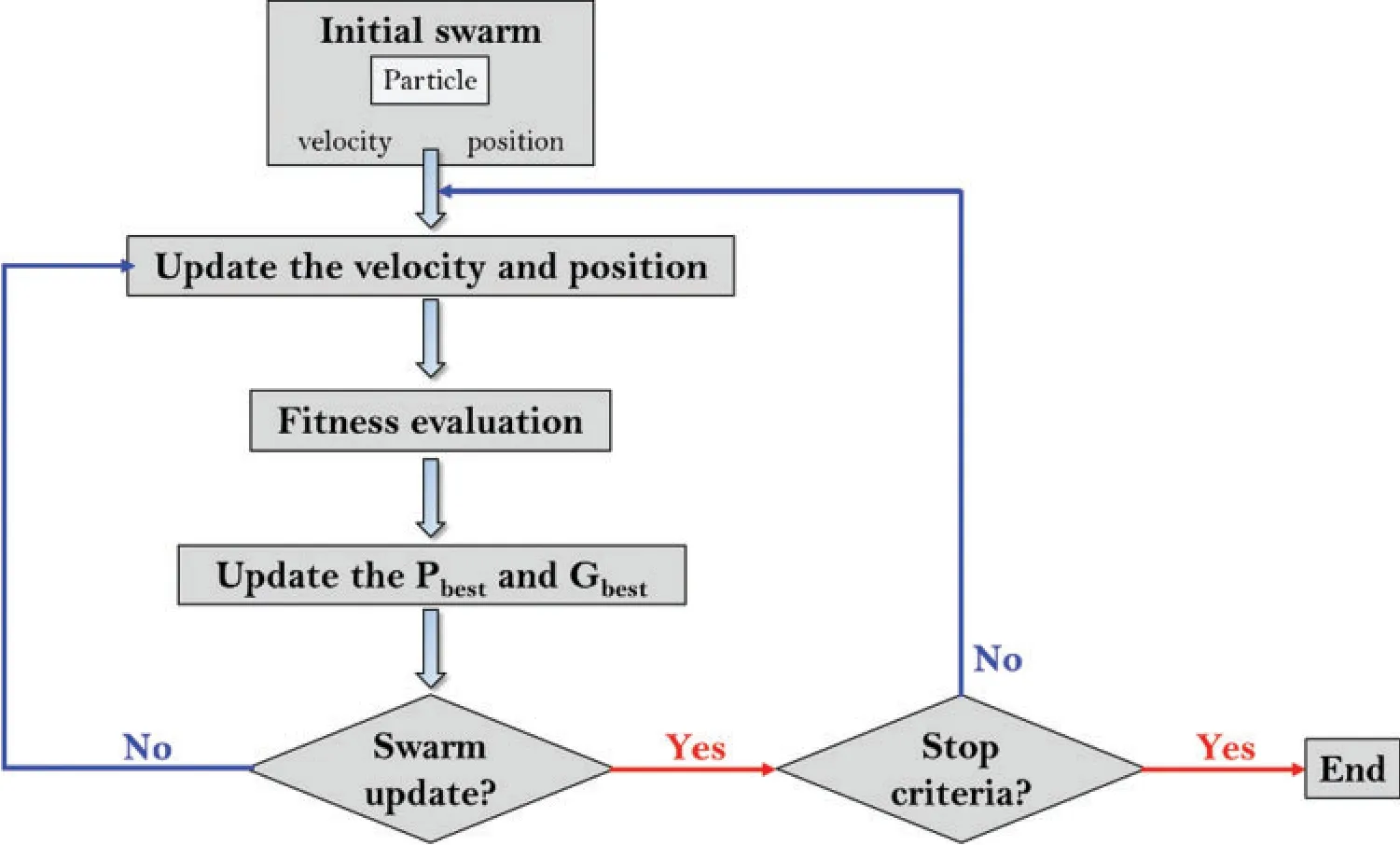
Figure 3:Flowchart of the PSO algorithm
3.2 Dataset Collection
In the present study,The 84 groups of permeability tests (7 types of PC with different aggregate combinations; 3 different sample thicknesses; 4 different clogging conditions)were carried out to simulate the clogging behavior of the PC.Aggregates of 4 types (which are named G1,G2,G3,and G4)were used to produce the PC.The aggregate sizes of G1,G2,G3,and G4were 2.36-4.75 mm,4.75-9.50 mm,9.50-16.0 mm,and 16.0-19.0 mm,respectively.Generally,the typical water-cement ratio of PC ranges from 0.29 to 0.33,and 0.3 was selected here for preparing samples [5,8,41] without considering its effect in the modeling process.The aggregate-cement ratio was determined to be 4.5 based on previous studies [51,52].In 1 m3of pervious concrete,the weight of aggregates,cement,and water used was 1,620,360,and 110 kg,with the high-range water reducer volume of 700 ml.The samples were cured in a moist cabinet at 95% humidity and 20°C for 24 h,and then demoulded and placed in the isothermal curing cabinet at the specified humidity and temperature for 28 days.
The design of the PC mixtures was conducted with the varying proportions of the four types of aggregates (see Table 1).PC samples with 3 different thicknesses (which are 50,75,and 100 mm)were adopted.Clogging sands of 3 types (the average sizes of which are 0-0.25 mm,0.25-0.5 mm,and 0.5-1 mm)were employed to simulate the clogging behavior.The testing results of the permeability coefficients for varying PC and clogging sands are given in Table 1 (k0andk1mean the permeability before and after the clogging test,respectively).
The dataset collected can be summarized in Table 2.

Table 1:Testing results of the permeability coefficients

Table 2:Summary of the dataset collection
Fig.4 gives the matrix diagram of correlation coefficients.
It can be observed from Fig.4 that the correlation coefficients of the most input parameters are lower than 0.5,showing that these input parameters cannot raise the issue of multicollinearity problem according to the study by Koopialipoor et al.[53].Therefore,these input parameters can be employed to conduct the machine learning process to simulate the clogging behavior of PC under the clogging materials.
3.3 Model Validation
Two coefficients,RMSE (root-mean-square error)and R (correlation coefficient),were employed to conduct the model validation process by evaluating the predictive performances of the models developed in the present study.Regarding the RMSE,it is defined by the following equation:

in which y∗irepresents the predicted permeability coefficient; yirepresents the measured value of the permeability coefficient; n is the number of PC samples to conduct the permeability tests.R is determined by the following equation:

in which the y∗iand yirepresent the predicted and measured values of the permeability coefficients.
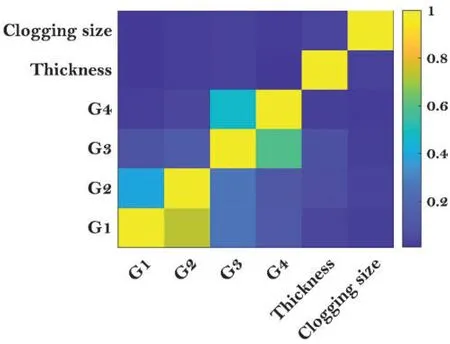
Figure 4:Matrix diagram of correlation coefficients
3.4 Hyperparameter Tuning
In the present study,the 10-fold cross-validation method was employed for the hyperparameter tuning process.In this method,the dataset of the permeability coefficients is divided into 10 subsets,in which the 9 subsets are used for the training process and 1 subset is employed to validate the predicted results.Regarding the 1 subset used to validate the predicted results,the minimum value of the RMSE should be determined after the 20 iterations to represent the optimized structure of the SVM model in this fold.That is to say; such a validation process should be conducted 20 times using the PSO algorithm to obtain the hyperparameters of the SVM model.Finally,the optimized structure of the SVM model and the corresponding hyperparameters can be determined after the cross-validation of 10 times.It should be noted that since there is the possibility of overfitting,the predicted performance of the SVM model is required to validate by comparing the testing dataset.
4 Results and Analysis
4.1 Performance of the PSO Algorithm
To determine the best form of the SVM model,the hyperparameters were tuned by the 10-fold cross-validation by evaluating the RMSE values obtained from the testing dataset.After the 10 folds of cross-validation during the hyperparameter tuning process,the relationship between the fold number and RMSE can be obtained,as shown in Fig.5.
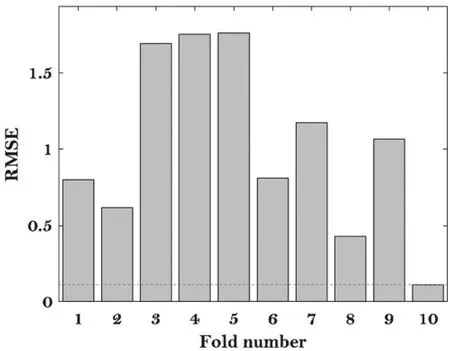
Figure 5:Relationship between the fold number and RMSE
As can be seen from Fig.5,the minimum value of RMSE (0.12 mm/s)can be obtained at the tenth fold in the dataset for verification.Therefore,the hyperparameter obtained at the tenth fold was used in this study to construct the SVM model for the permeability prediction of PC.Fig.6 gives the relationship between the iterations (which have been conducted 20 times in this study)and RMSE.

Figure 6:Relationship between the iteration and RMSE using the PSO algorithm
It can be observed from Fig.6 that the values of the RMSE greatly decreased as the iteration time increases,proving that the PSO algorithm can be useful to adjust the SVM model.In addition,after about 8 iterations,the RMSE value can achieve convergence and nearly reach the minimum value,showing that the best model structure of the SVM is determined in this folding.In the process of 10-fold cross-validation,the optimal SVM model in the whole process was selected after 10 times,and the corresponding optimization hyperparameters were determined.It is worth noting that the predictive results of the SVM should be validated by evaluating the testing dataset.
4.2 Performance of the SVM-PSO Algorithm
After the hyperparameters tuning,the predictive performance of the SVM-PSO algorithm to evaluate the permeability and clogging behavior was conducted.Figs.7 and 8 show the comparison results between the measured and predicted permeability regarding the training and testing datasets,respectively.
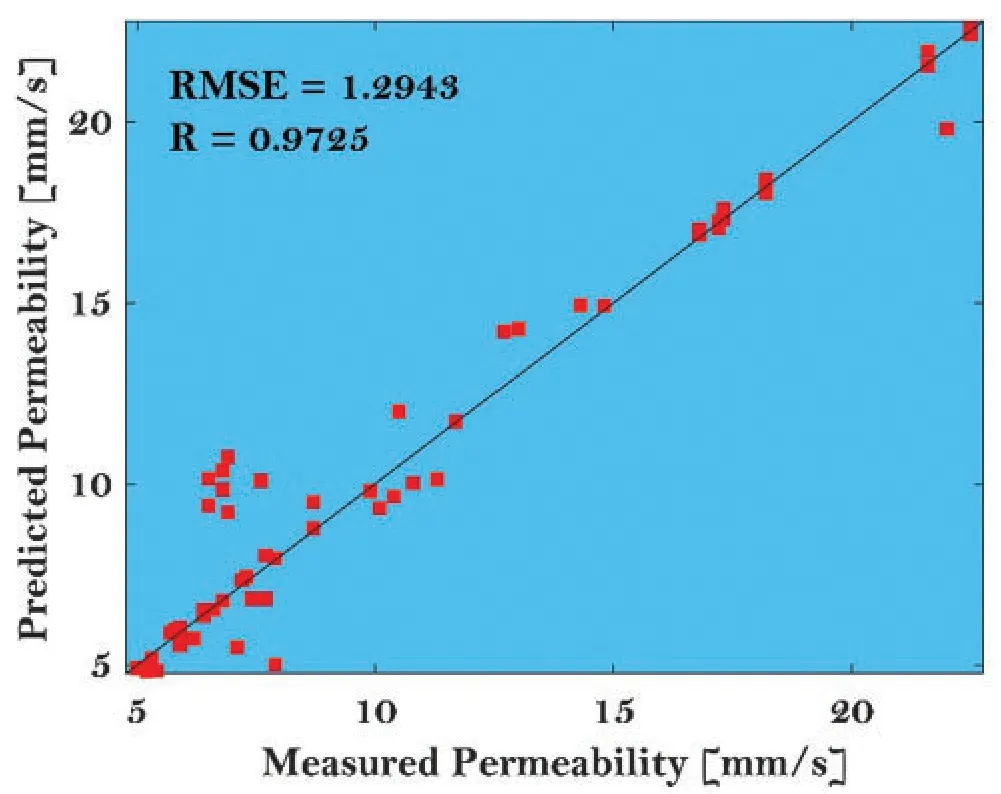
Figure 7:Results of the training dataset
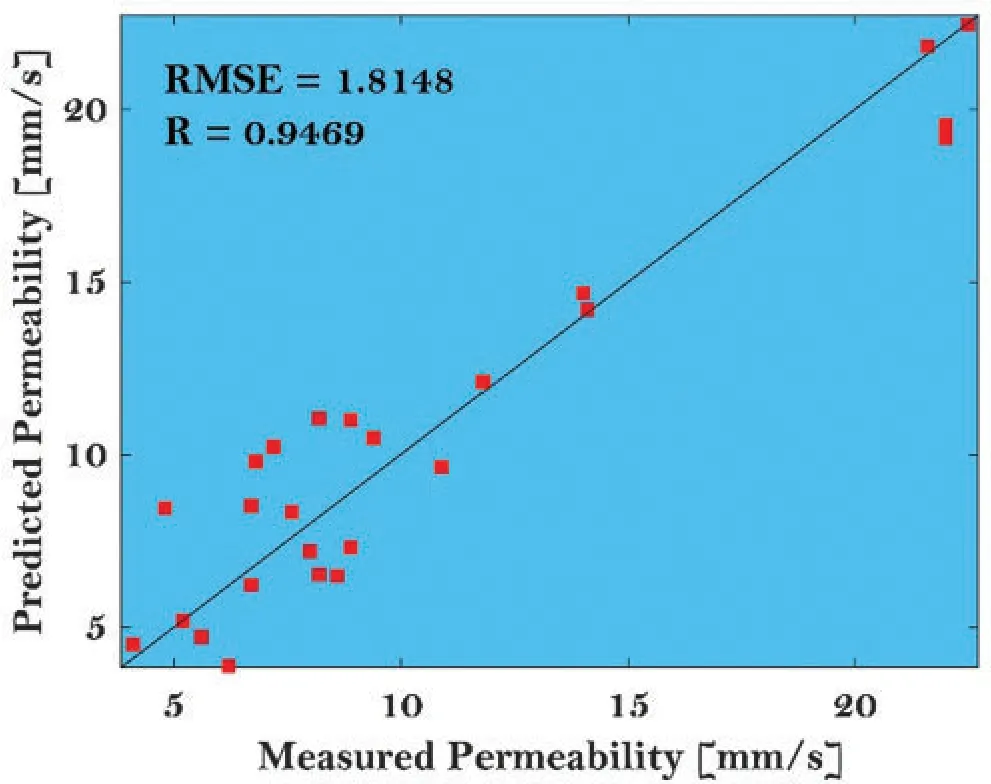
Figure 8:Results of the testing dataset
It can be seen from Figs.7 and 8 that the predicted permeability is in good agreement with the measured permeability (when the PC was faced with the clogging sands with sizes),indicating that this method can well establish the nonlinear relationship between the clogging behavior and the input variables (including the composition of the aggregate sizes in the concrete,sample thicknesses,and the clogging sand sizes).The statistical parameters for these comparisons between the training and testing datasets were further obtained,as shown in Figs.7 and 8.The RMSE values of the training and testing dataset were 1.2943 and 1.8148,respectively.The higher values of R for the training and testing dataset are 0.9725 and 0.9469,respectively.The above results show that the proposed SVM-PSO algorithm did not have the issue of overfitting during the modeling process.
Fig.9 (training dataset)and Fig.10 (testing dataset)give the comparison of the measured and predicted dataset regarding each data number.The histogram in the figures represents the difference between the measured and predicted ones.The results also show that the measured values are in good agreement with the predicted values except for a few noise points.These results are acceptable to prove that the proposed SVM-PSO algorithm can better predict the permeability and clogging behavior of PC.
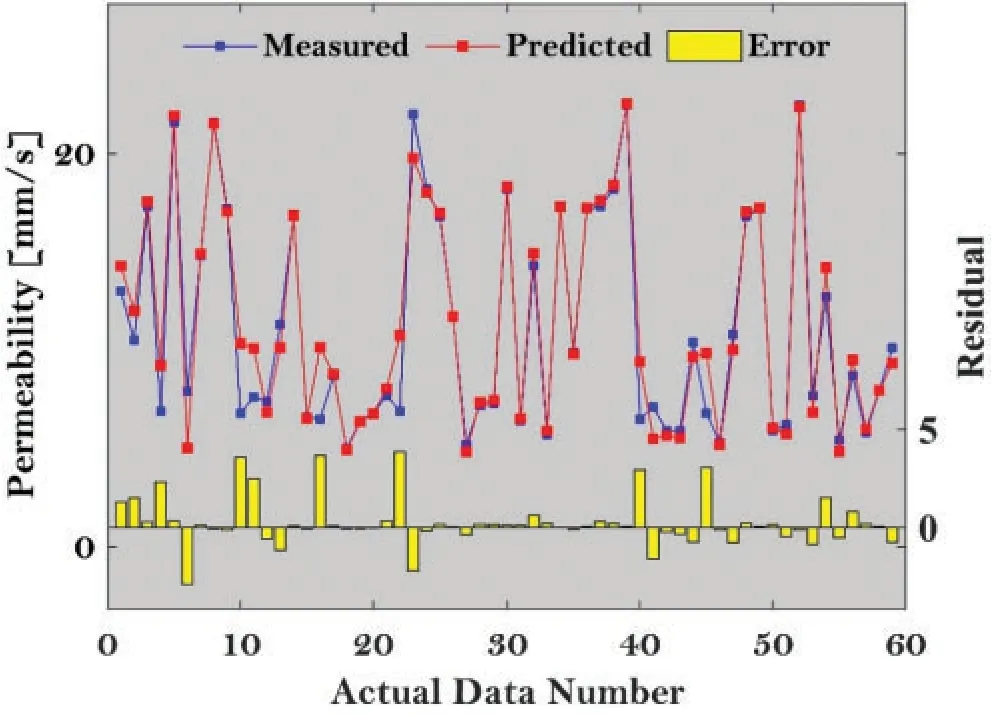
Figure 9:Comparison of the measured and predicted permeability regarding the training dataset

Figure 10:Comparison of the measured and predicted permeability regarding the testing dataset
4.3 Variable Importance for the Permeability of PC
The relative importance of the varying design parameters was also evaluated in this study.The proportions of G1-G4,and sample thickness are the influential variables concerning the PC itself while the clogging size is the external factor that determines the clogging behavior (permeability coefficient after clogging).Fig.11 shows the importance scores of these input parameters employed as the input in the SVM-PSO algorithm.
In Fig.11,the value corresponding to each parameter indicates its importance score.The changes in parameters with higher importance scores have a greater impact on the clogging behavior (permeability coefficient after clogging)of the PC.It can be seen from Fig.11 that the size of the clogging sand is the most important parameter that affects the clogging behavior,indicating that as the size of the clogging sand varies from 0.25 to 1 mm,its response to the clogging behavior is extremely significant.Therefore,in the future laying process of the PC in the actual road pavements,the clogging sands within this size range (0.25-1 mm)should be considered to avoid the clogging behavior.The thickness of the sample is the least significant factor affecting the clogging behavior.In fact,this is easy to understand,as most experimental studies on PC do not specifically focus on the sample thickness of PC.The proportions of G1aggregate (the smallest aggregate size)and G4aggregate (the largest aggregate size)are the two most important design parameters of concrete,which indicates that the influence of G1aggregate and G4aggregate on the seepage attenuation behavior of PC is significant.Therefore,these two aggregates should be given special attention in future PC design for anti-clogging purposes.

Figure 11:Variable importance for permeability of the PC
It can be seen from Fig.12 that there is a negative correlation between the proportion of G1aggregate and the permeability coefficient (see Fig.12a),indicating that the aggregates of small size are not conducive to the permeability of permeable concrete.This is because the small size of aggregate is easy to fill into the skeleton structure and reduces the air voids.However,regarding the G2,G3,and G4aggregates,the influence of the aggregate proportions on the permeability coefficient is relatively random (see Figs.12b-12d).Also,it can be observed that thickness is a favorable factor for the permeability of the pervious concrete,which can be inferred from the positive correlation in Fig.12e.This may be because more permeable paths appear in the thicker concrete specimens,increasing the permeability coefficients.From Fig.12f,it is obvious that the size of the blocking particle is an unfavorable variable for the permeability coefficient.Larger clogging particles can significantly reduce the permeability coefficient of pervious concrete.
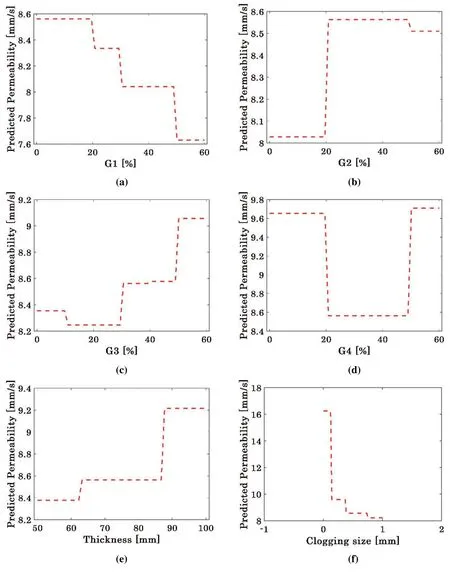
Figure 12:Sensitive analysis of different input variables:(a)Proportion of G1 aggregate; (b)Proportion of G2 aggregate; (c)Proportion of G3 aggregate; (d)Proportion of G4 aggregate; (e)Sample thickness; (f)Clogging sand sizes
5 Conclusions
This study aims to evaluate and predict the clogging behavior,one of the most durable properties of the PC in the mix design,using hybrid machine learning techniques.Based on the 84 groups (varying proportions of aggregates with different sizes,varying sample thicknesses,and varying clogging sands with different sizes)of the dataset developed in the earlier study,the clogging behavior of the PC can be determined by the algorithm combing the SVM and PSO methods.Specifically,the PSO algorithm is used to adjust the hyperparameters of the SVM and verify the results using 10-fold cross-validation.The prediction results of the optimized model were evaluated by R and RMSE.In addition,this study also reveals and discusses the importance of the influence on the clogging behavior of the PC from the perspective of internal and external causes.The conclusions obtained can be highlighted as follows:
(1)The PSO algorithm can effectively adjust the hyperparameters of the SVM model and can be used to construct the predictive model for the clogging behavior of the PC.The combined algorithm has the advantage of higher reliability and validity than the random hyperparameters selection.The developed machine learning model can accurately be used to evaluate and predict the clogging behavior of the PC,guiding the mix-design of PC from the perspective of durability.For the verification process,the developed model was able to obtain values of 0.9469 and 1.8148 for the R and RMSE,showing that the developed machine learning model can accurately be used to evaluate and predict the clogging behavior of the PC,guiding the mix-design of PC from the perspective of durability.
(2)From the perspective of the influential ranking to the clogging behavior in the PC,the size of the clogging sand is the most important parameter,indicating the clogging sands within this size range (0.25-1 mm)should be considered to avoid the clogging behavior.The thickness of the sample is the least significant factor affecting the clogging behavior.The proportions of G1 aggregate (the smallest aggregate size)and G4 aggregate (the largest aggregate size)are the two most important design parameters of concrete,showing that the influence of G1 aggregate and G4 aggregate on the seepage attenuation behavior of PC is significant.Therefore,these two aggregates should be given special attention in future PC design for anti-clogging purposes.
Considering the limitation that only 84 datasets of permeability were employed in this study,more testing results should be collected to improve the accuracy of the developed machine learning model regarding future development.A model comparison study should be carried out as well to evaluate the efficiency and accuracy of different machine learning models in the prediction.Also,a user-friendly tool should be developed in the future to facilitate the practical application of engineers.
Acknowledgement:The authors thank the “Qihang Plan” of China University of Mining and Technology.
Funding Statement:This research was funded by the “Qihang Plan”of China University of Mining and Technology.
Conflicts of Interest:The authors declare that they have no conflicts of interest to report regarding the present study.
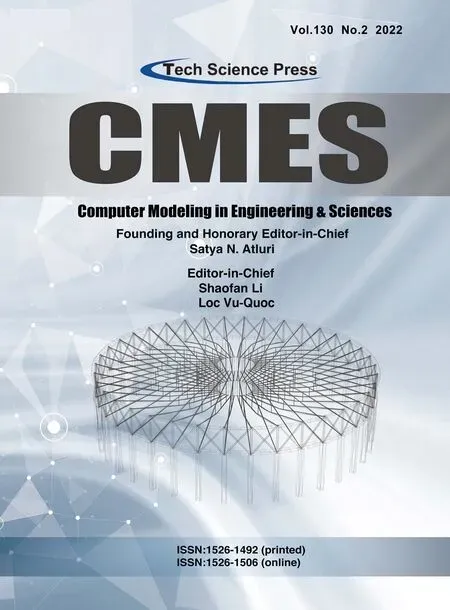 Computer Modeling In Engineering&Sciences2022年2期
Computer Modeling In Engineering&Sciences2022年2期
- Computer Modeling In Engineering&Sciences的其它文章
- A Chopper Negative-R Delta-Sigma ADC for Audio MEMS Sensors
- Human Stress Recognition from Facial Thermal-Based Signature:A Literature Survey
- The Material Deformation and Internal Structure Development of Granular Materials under Different Cyclic Loadings
- Estimating Daily Dew Point Temperature Based on Local and Cross-Station Meteorological Data Using CatBoost Algorithm
- CFD-Based Evaluation of Flow and Temperature Characteristics of Airflow in an Aircraft Cockpit
- Performance Analysis of Magnetic Nanoparticles during Targeted Drug Delivery:Application of OHAM
